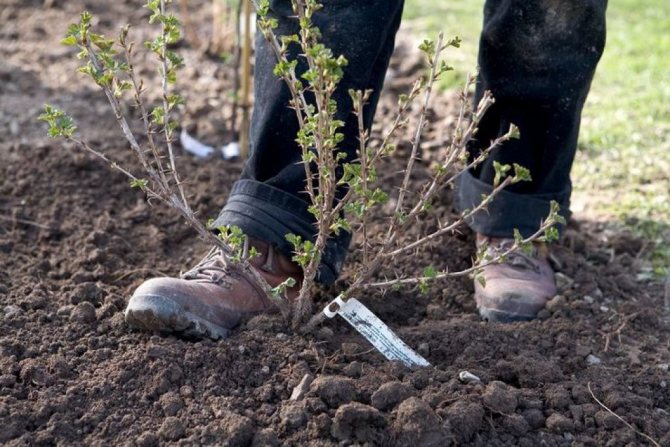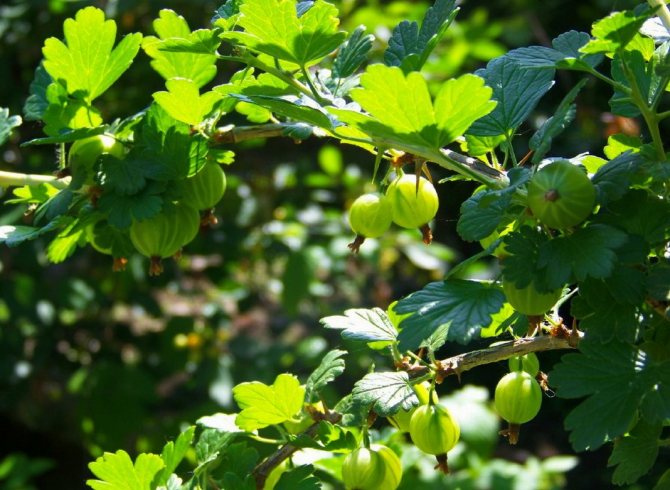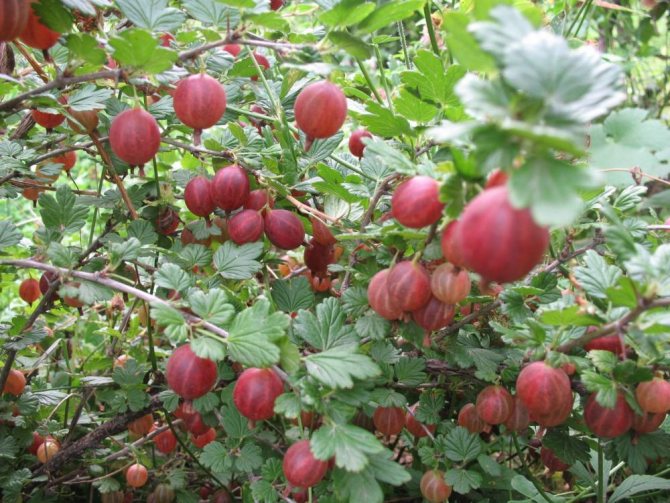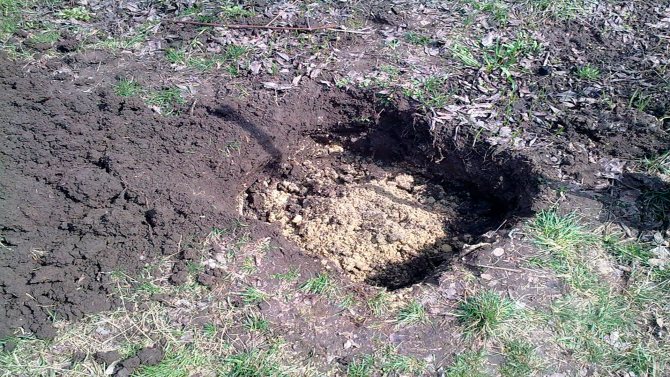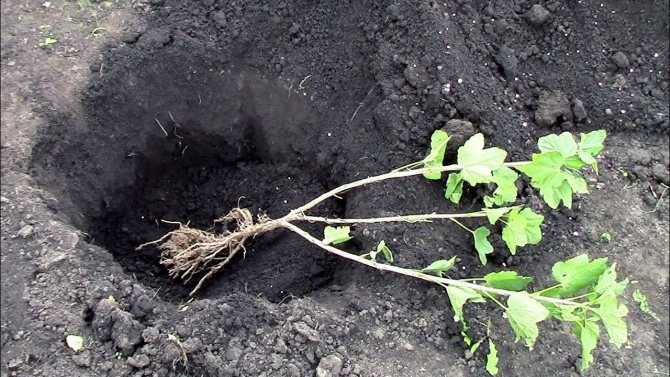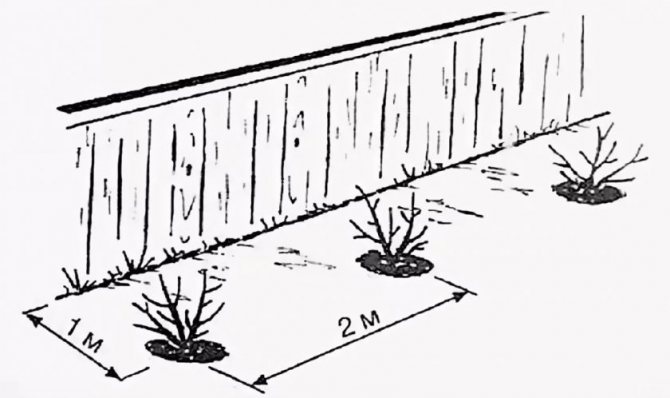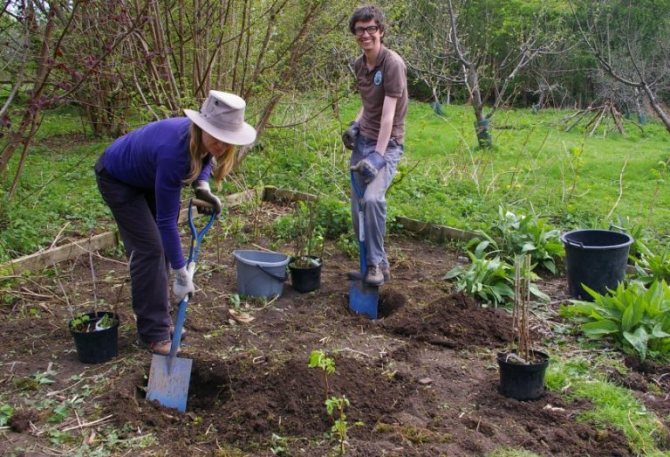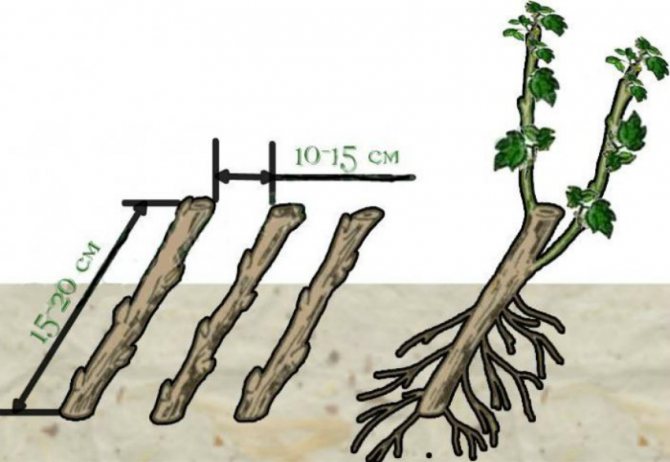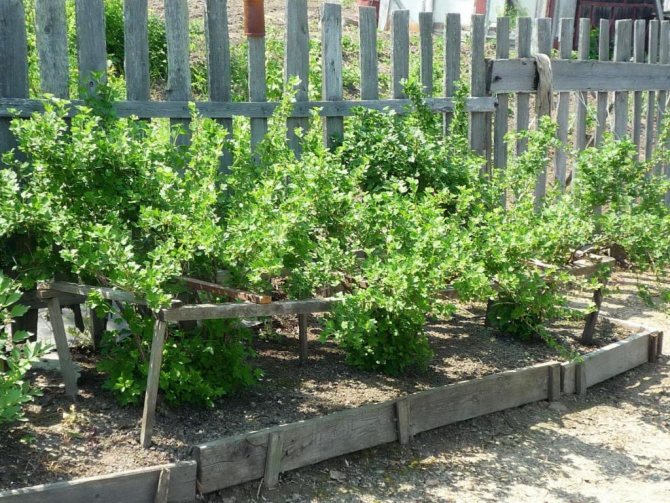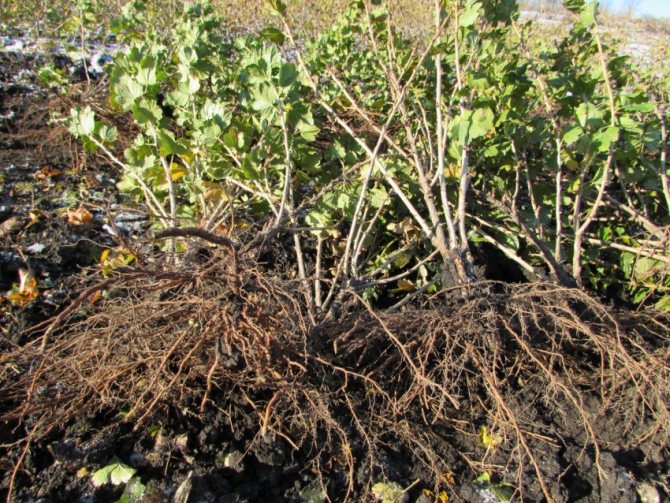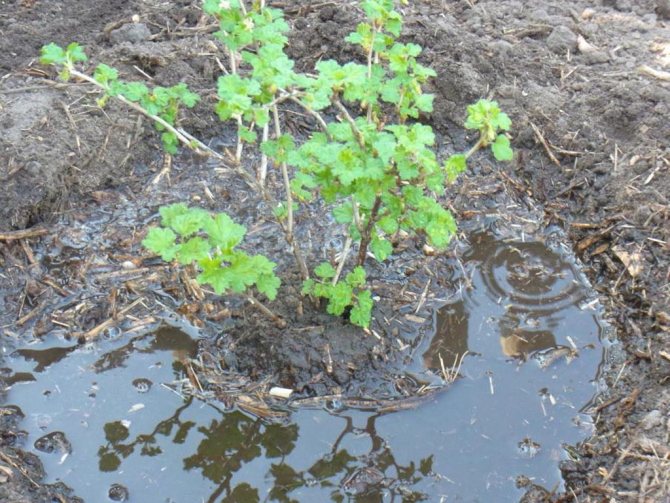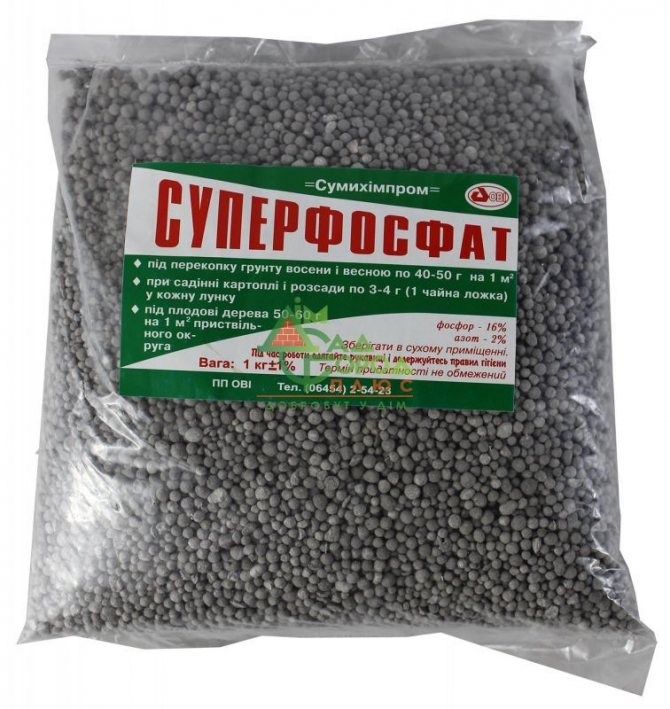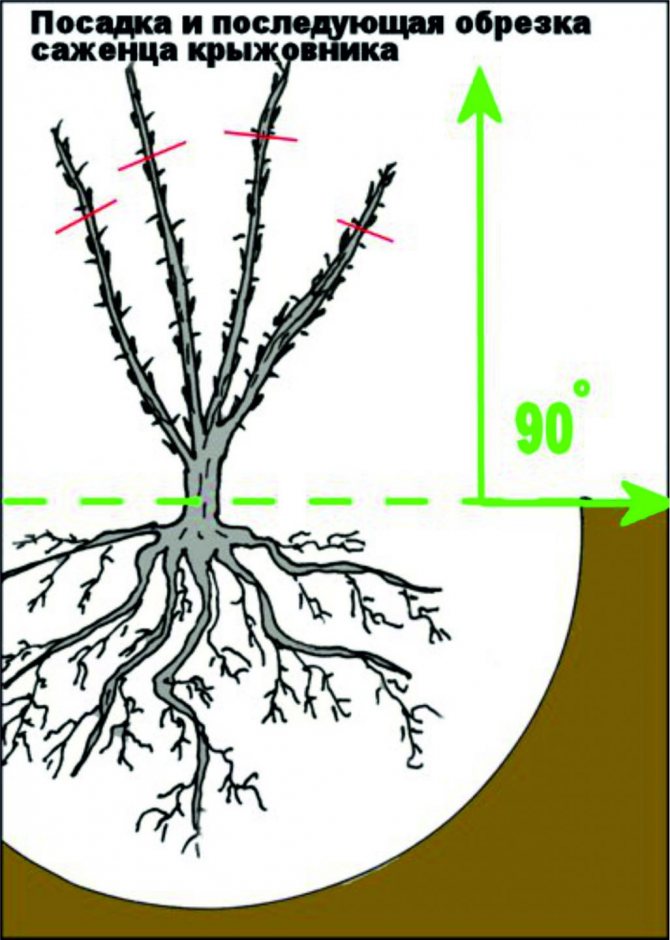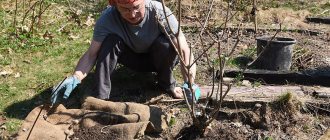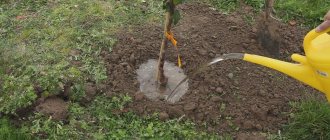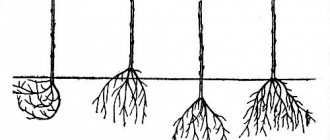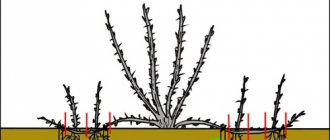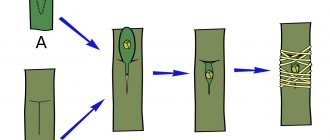Autumn is always a busy time of the year. After all, you need to have time to harvest, clear the beds, dig up, send for storage or use the fruits grown over the summer and at the same time remember to enjoy the last warm days and transplant all the plants that are cramped in their old places. The topic of this article is the timing and ways to transplant gooseberries to a new place in the fall.
- 1 Why transplant
- 2 Best time to transplant
- 3 Choosing a place and preparing the soil
- 4 Transplant technology
- 5 Video "Autumn gooseberry transplant"
When to plant gooseberries - in autumn or spring
Gardeners plant the bushes twice a season. Each option has advantages and disadvantages:
- planting gooseberries in the fall is considered the best option. This is due to the fact that overgrowing roots grow more actively at low temperatures. During the winter, the soil compresses well around the roots. In spring, it is easier for plants to take root and the bushes will develop faster;
- gooseberries are also planted in spring, but you can't hesitate. It is necessary to start planting seedlings as soon as the soil thaws. If you miss the deadline, then the gooseberry will be more difficult to take root. The beginning of the season is an excellent period for the propagation of bushes by layering.
Oktyabrina Ganichkina notes that for breeding varieties growing on the site, seedlings can be grown from cuttings, cuttings. If you want to get acquainted with new varieties of gooseberries, buy seedlings.
Features of planting gooseberries in autumn, taking into account climatic conditions
To harvest a good harvest, the ripening time of berries must be taken into account:
- early gooseberries (Orlyonok, Rodnik, Yarovaya) can be enjoyed in the second half of June;
- medium varieties - Moscow red, Prune, White triumph;
- late varieties Date, Malachite, Serenade begin to ripen from the second half of August.
When planting gooseberries in autumn, it is important to take into account the climatic characteristics of the regions. To choose the optimal planting time, you need to focus on the autumn frosts.
Depending on the region
In order for the bush to take root, it is important not only to know how to plant gooseberries in the fall, but also to choose the right time. Saplings are planted 4-6 weeks before the first negative temperatures:
- in the central and northern regions of Ukraine, it is recommended to plant gooseberries in early October. The average temperature in the northern regions is 4-9 ° С, in the center - 5-8 ° С. Can be planted at the end of October, but the bushes will develop more slowly;
- in Siberia, in the Urals, seedlings are planted in early autumn (early September) and insulated with organic materials (7-10 cm layer);
- in the Moscow region and the Leningrad region, they have been planting seedlings since the second half of September.
Landing dates for the lunar calendar 2018
To know exactly when to plant gooseberries in spring or fall, you can use a gardener's calendar.
- In September, it is recommended to plant gooseberries in the following numbers: 1-2, 4-7, 13-20, 27-29.
- Suitable days in October: 4-7, 12-13.
How to plant gooseberries in the fall
To get healthy gooseberry bushes that will delight you with a stable harvest for many years, you need to follow the agricultural techniques of planting gooseberries in the fall. In this case, the seedlings will quickly take root and, in the next season, will give young shoots, and possibly pamper gardeners with a small amount of fruits.
Seat selection
This is the first place to start when planning to plant gooseberries with seedlings in the fall. Berry culture prefers sunny, protected from wind and drafts. Light shading is allowed in hot midday hours.
Do not plant gooseberries under the crowns of large trees, near the walls of tall buildings. The best place is the southern or eastern side of hedges or garden buildings, small hills, protected from northern winds. Lowlands and places where underground waters come close to the surface are also avoided, since the plant does not tolerate waterlogging poorly.
For gooseberries, both the mechanical composition of the soil and the chemical are important. The culture shows the best results on light, neutral soils, with a high content of nutrients. But if the mineral composition can be easily adjusted with the help of fertilization, then growing gooseberries in areas with clay or sandy soils will not bring the desired results.
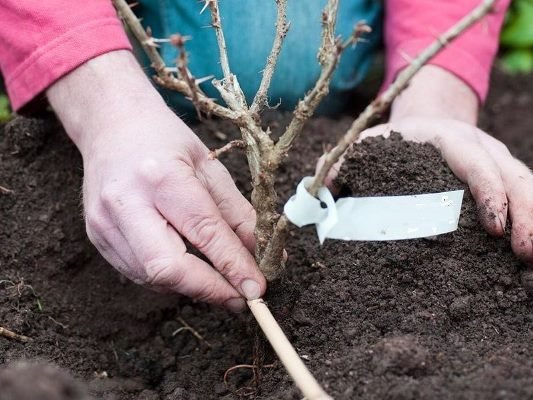
In the first case, the root system is threatened with jamming during the melting of snow and heavy summer rains, which threatens the development of fungal diseases. In sandy areas, the bushes will require frequent watering. With a lack of moisture, the berries are small, with a tough skin.
Therefore, with proper planting of gooseberries, in the fall, areas with loamy or sandy loam soils are chosen. If necessary, carry out their training.
Attention!
When choosing a place, it should be borne in mind that gooseberries are a perennial culture, prone to overgrowth. It is worth considering in advance how the bush will look in the chosen place after a few years, so that later you do not have to transplant it.
Desirable and unwanted neighbors
You should also remember about the neighbors of the gooseberry. It is believed that he himself is the best neighbor for a gooseberry. Fruit trees do not take moisture and nutrients from the gooseberries, since their root systems are located at different levels. But their crowns make it difficult for light to reach the bushes.
Black currants and raspberries are also bad neighbors. On the one hand, they have such common pests as sawfly, aphids, moths. In addition, the raspberry itself has roots that spread over a large area, drowning out the plants growing nearby.
Sage, lemon balm, mint or basil bushes are planted next to the gooseberry. Tomatoes, which scare away pests with the smell of tops, will become a good neighbor. You can also plant gooseberries near fruit trees: pears, apple trees, cherries, keeping a distance so that the crown of the trees does not shade the bushes.
Soil preparation
As the gooseberry planting date approaches, preparatory work begins in the fall. First of all, this applies to holes and soil.
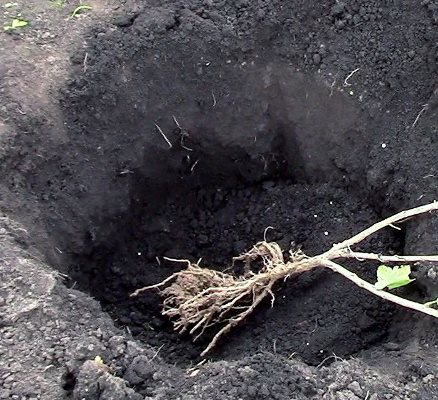

The diameter of the planting hole when planting seedlings with an open root system is about 50-60 cm. When planting seedlings with a closed root system, the hole is made 2-3 times larger than the container in which the seedling grew. It is important to preserve the soil layer on its roots as much as possible.
The depth of the hole should be at least 50 cm. Otherwise, it depends on the fertility of the soil on the site. If she is fertile, then that depth will be enough. If not, then it is better to deepen it by 10-15 cm in order to arrange a higher fertile layer.
Prepare the soil mixture. The removed soil is mixed with compost or humus, which is added from 1 to two buckets. The compost is used rotted. On alkaline or neutral soils, add 0.5 buckets of peat. If the soil is acidified, then it is better not to use peat. And add 300-400 grams of dolomite flour or 1-2 liter cans of wood ash.
River sand, rotted sawdust, vermiculite are used to loosen heavy soils. Clay is added to light sandy soils.
Many gardeners recommend immediately filling the soil with microelements. For this, superphosphate or any complex fertilizers are used, which include phosphorus, potassium and magnesium.Mix the soil well and fill the wells with it to the middle.
When planting gooseberries in the fall, it is important to maintain a balance in the applied fertilizers. After all, the next feeding will be only in early spring.
Preparing gooseberry seedlings for planting
The phrase "planting gooseberries correctly in the fall" also implies the correct choice of seedlings and their preparation for planting.
There is a lot of planting material on sale in the fall. You need to choose two-year-old seedlings with a well-developed and healthy root system. The minimum root length should be at least 25-30 cm. The aboveground part of the plant should have 2-3 strong shoots, also about 30 cm long, without visible damage.
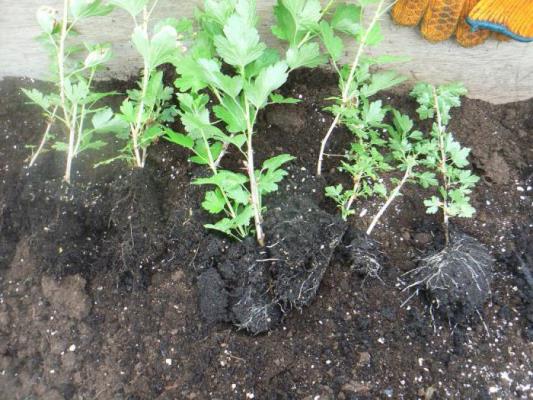

When buying seedlings with a closed root system, the plant should be leafy and should not wobble in the container. If it is poorly fixed, then there is a possibility that the sellers simply transplanted an ordinary seedling, possibly with an underdeveloped root system, into a container.
In the fall, gooseberries are planted not only with seedlings, but also with cuttings or layering. Layers are carefully separated from the main bush beforehand. The planting material is examined and the strongest and most viable shoots with large buds are selected.
Purchased seedlings do not need pruning before planting. It is carried out in nurseries. Cuttings and layers may need to be shortened somewhat. The same applies to the roots of seedlings purchased without containers. Dried roots are pruned or removed, long ones are shortened to 25-30 cm.
Attention!
Immediately before planting gooseberries in the fall with cuttings or seedlings with an open root system, it is recommended to soak their root system for 0.5-1 hour in a solution of any growth stimulant. For example "Kornevine". Especially the procedure will not interfere with plants that have been stored for some time since the purchase at home.
Breeding options
When growing a crop, it must be borne in mind that the bushes are actively growing and bearing fruit on ventilated, well-lit lands.
Gooseberries do not like stagnant water, therefore, 1.5-2 m from the surface is the optimal level of groundwater. If the waters are higher, then it is necessary to plant the bushes on pre-prepared shafts approximately 1 m wide.
Using layering
This breeding method is used most often and it is suitable for plants 3-4 years old. Advantages of the method - about ten high-quality cuttings can be obtained from one bush at the same time. It is better to breed gooseberries in this way in the spring, since it is during the summer season that the cuttings take root.
This method is a great option for getting your own seedlings for planting gooseberries in the fall months.
- Annual branches are selected on the sides of the bush. Shoots are placed in pre-prepared furrows (at least 10 cm deep).
- Since the branches are not buried in soil, it is necessary to make sure that they practically lie on the ground. To do this, they are fixed with wooden studs. The tops of the branches are pinched by about 2-3 cm.
- When branches about 5 cm high grow from the buds, you can sprinkle the layers with soil a little.
- When the branches grow another 10-15 cm, they are covered with wet earth literally to the tops. As the branches grow, their hilling continues. If the shoots grow very quickly, you need to pinch the tops so that the gooseberry begins to branch out.
In autumn, the layers are separated from the main bush and planted in a dedicated area. From one layer, 4 to 6 shoots are obtained.
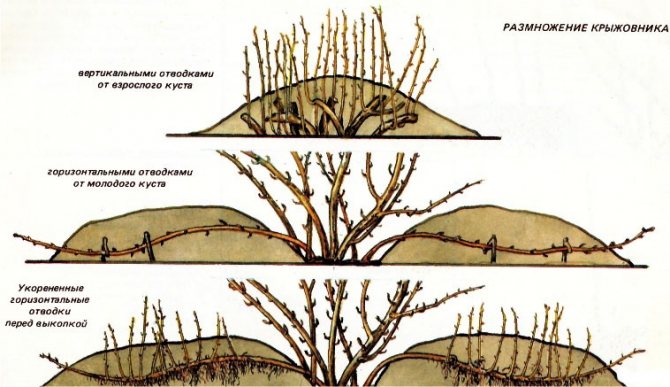

Propagation by cuttings
When choosing this method of breeding a shrub, it is important not to skip a period suitable for harvesting cuttings. In early July, the growth of branches slows down - these are the optimal days for cuttings. Twigs cut earlier / later take root less well.
The success of cuttings is also determined by the variety of the shrub.
- In the morning, branches are harvested with a height of 15-19 cm, having 6-8 nodes. If difficult-to-root varieties are bred (Polonez, Consul, Cooperator), then you need to take the tops of the branches.
- Cuttings are immersed in a composition that stimulates root formation for 6-8 hours.
- The twigs are buried in specially prepared soil (peat and sand are mixed in equal parts). It is enough to deepen the cuttings by 2-3 cm. The earth is slightly moistened.
In order for the twigs to take root well, it is advisable to plant them in greenhouses (so that it would be easier to maintain an air temperature of 20-27 ° C for 10-15 days).
At the beginning of the season, rooted cuttings are transplanted into open ground for growing. Already in the fall, you can transplant seedlings to the chosen place.
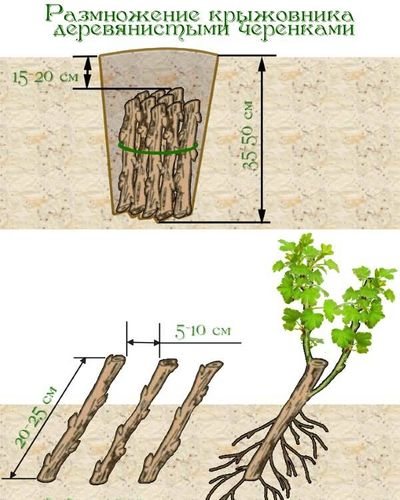

Bush cultivation with seedlings
When purchasing a seedling with an open root system (without a container), pay attention to the condition of the skeletal and pelvic roots.
- Since it is the skeletal roots that germinate to a considerable depth, the seedlings should have about three roots 15-20 cm long. The surface of the skeletal roots is usually covered with a yellowish bark.
- Fibrous suction roots develop at a depth of 15-50 cm.
The aboveground part of the seedling is formed by 2-3 branches with a height of 30-40 cm. Before planting, the branches are shortened - they are left no higher than 15-20 cm. It is desirable that each branch has at least 4-5 buds.
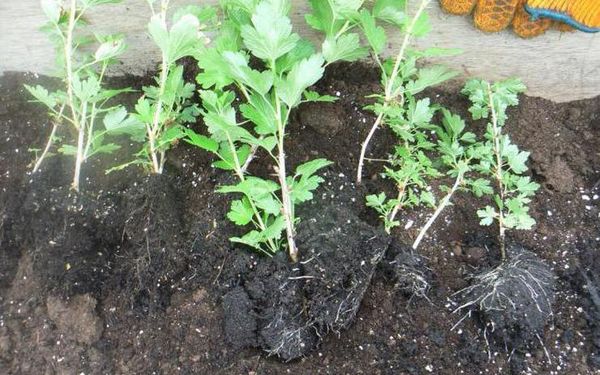

When preparing the site, it is necessary to decide for what purpose the plant is planted. If you plan to harvest the maximum yield from 2-3 bushes, then they are located at a distance of 1.3-1.5 m.If you want to harvest a bountiful harvest from the planting of bushes, then the gooseberries are planted more densely: a distance of 60-80 cm is left between the plants, and the aisles are made 1.2-1.5 m wide.
When choosing a seeding scheme for seedlings, take into account the varietal characteristics of the gooseberry.
- When breeding varieties with bulky bushes (Malachite, Serenade, Tender), the distance between individual plants is maintained at least 1.5 m.
- If the soil is highly fertile, then it is recommended to plant the bushes at a two-meter distance.
And early-growing varieties with a compact aerial part (English yellow, Jubilee) are planted denser. A distance of 0.8-0.9 m is left between the plants. But thickening should not be allowed, since good lighting is necessary for the full development of fruit buds.
How to plant gooseberries with cuttings. What are the best shoots to take?
For varieties such as Cooperator, Polonez, Consul, it is better to choose the upper parts of the branches of the first order, since these varieties are difficult to root.
In the case of easily rooted varieties (Black Velvet, Kiev Prize, Memory of Negrul), all parts of the shoots are suitable.
When the cuttings are cut, it is necessary to place them at the cut point in a growth stimulant solution (Energen, Heteroauxin) for about 6-8 hours. This will allow the root system to form better and faster.
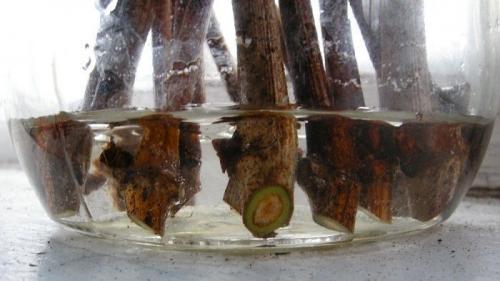

Cuttings are planted to a depth of 2 cm. The best soil mixture is sand and peat in equal proportions. Their survival rate largely depends on the gooseberry variety.
To a lesser extent - from climatic conditions, soil mixture and the concentration of nutrients in it.
Gooseberry propagation methods by cuttings:
- Green cuttings.
- Woody cuttings.
- Combined.
Green cuttings. Using this method involves propagating gooseberries by cuttings in the spring. It is most convenient to spend in the first 10 days of May. The optimal conditions for this are: air humidity about 90%, air temperature + 250C, and soil t0 + 180C.
Such conditions can be created in greenhouses or greenhouses. The basis for green cuttings is a 4 year old bush. The tops of young shoots are taken. They have a lower part more adapted for breeding. They are planted in the soil obliquely.
Preparation of cuttings is carried out as follows:
- All lower leaves should be trimmed initially.Only the top three leaves need to be left.
- A small longitudinal incision is made over each of the kidneys with a sharp knife. This is necessary for better rooting. In the lower part of the branch, about 3 such cuts are made along the trunk.
- The cuttings are dipped in a container of water for about 24 hours so that the plant gains the required amount of moisture.
- You can also then place the cuttings in a growth stimulant solution for about 8 hours (for example, Energen or Heteroauxin).
Cuttings are ready for planting in the soil of greenhouses. As for care, it is necessary to water and timely feed (twice a season).
Cuttings root well after three weeks. During this period, the greenhouse can be opened for the day, and covered back at night. After the first sprouts appear, the film can be taken from the greenhouse altogether.
Woody cuttings. This method is used for propagation of gooseberries by cuttings in the fall. The principle of the method involves tying woody cuttings into bundles with further placement in the soil. They are planted at the end of September. The depth should be about 15 cm.
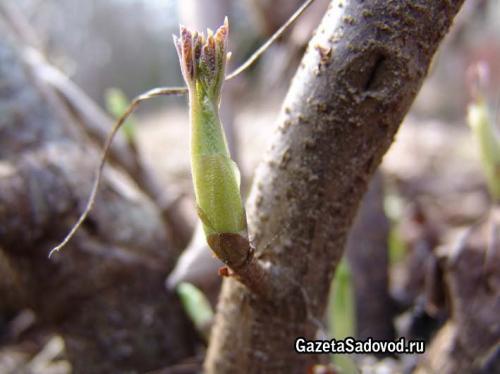

Above the surface of the soil, a small embankment is made with fertile soil. Next, a layer of mulch (sawdust, compost or humus) spreads. Above all, the area along a radius of 50 m. Is covered with plastic wrap in three layers. So they leave everything for the winter. The first shoots appear in the spring.
Propagation of gooseberries by cuttings in this way implies placing a bundle of cuttings about 25 cm long in the prepared hole, with the tops down and the roots up. The hole is covered with 15 cm. a layer of soil.
Why are woody cuttings planted upside down? The fact is that the upper part of the soil in spring warms up much faster than the lower one. Accordingly, the lower roots warm up faster. At the same time, the growth of the upper buds is delayed, which develop faster than the root system.
In the spring, these cuttings can be planted in the soil. The depth of the hole should be such that 2 buds are visible on the surface. The cuttings should be placed obliquely, at an angle of about 450. The distance between them should be kept at 10 cm.
Combined cuttings. The main advantage of this method is the ability to multiply several varieties at the same time. To do this, you can use mini-greenhouses. The method involves the propagation of gooseberries by green cuttings and two-year-old woody ones. They are planted in one hole.
Wood cuttings have a longer growing season than green cuttings. Their first shoots appear the next season in the spring. Young green seedlings will already have their first fruits by spring, and annual shoots of woody cuttings will only knock out the first shoots.
When they reach 50 cm in height, their mono will be separated from the mother bush and planted in a new place. Thus, in the process of growing gooseberries, the summer resident receives seedlings of his favorite berry completely free of charge.
Planting stages
How to plant gooseberries in the fall:
- Dig holes with a depth of 45-50 cm and a diameter of at least 40 cm. Moreover, the upper nutrient soil is placed separately.
- Fertilizers when planting gooseberries in the fall: a bucket of humus is mixed with superphosphate 200 g, potash fertilizers 60 g, limestone 50 g. Top dressing is poured onto the bottom of the pit. A part of the previously dug fertile soil (in the form of a mound about 10 cm high) is covered from above.
- The seedling is carefully placed in the center of the pit. The roots are carefully straightened. The gooseberry root system is covered with the remaining fertile soil, and it is advisable to lightly shake the bush so that the earth fills the voids in the root system. The soil is slightly moistened.
- Next, the pit is filled in layers with earth, moistening each layer of soil. The importance of this method is that the moist soil is naturally compacted and voids between the roots are eliminated. The bush takes root better, since the root system is practically not damaged.
- If there is no time to alternate watering and planting, you just need to water the bush after digging in. It is not advisable to specially compact the ground before watering. The root collar of the plant should not be heavily covered (no higher than 3-5 cm).
Agrotechnical cultivation
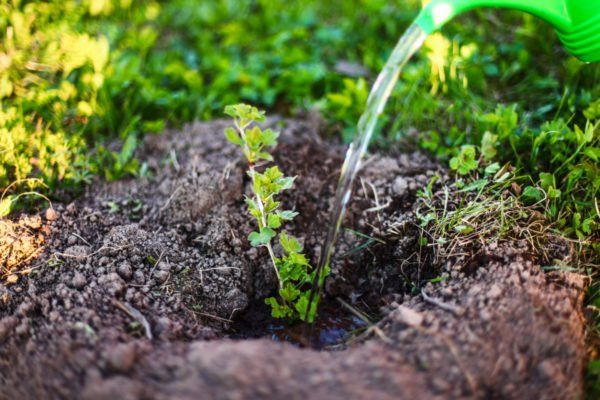

In order for the gooseberry to fully bear fruit and develop correctly, the optimal place on the site is selected for it. This culture loves sunshine and moderately moist land. In swampy areas, as well as in the shade, the growth of the bush will be less intense, the branches may stretch out, and the berries will not reach normal size. The quality of the seedling, together with proper planting, is also important for the development of the plant.
For your information!
When buying planting material with an open root system (OCD), it is advisable to choose two-year-old samples. For closed OCD, the age of the plant is not important.
Landing
Planting seedlings in a permanent place is the initial stage of cultivating a berry plant in a garden plot. The further development of the plant will depend on how the procedure is performed. Planting implies the selection and preparation of seedlings, the selection of a place, the introduction of fertilizers into the soil. In addition, predecessor cultures are taken into account. It is not recommended to plant gooseberries after raspberries or currants, as they have "common" pests.
Preparation of seedlings
It is better to purchase planting material in fruit nurseries or garden centers. Then the declared plant variety will be true. seedlings are of three types: with an open root system, with a clod of earth, in trays. In the first case, the plant roots are practically bare. Such specimens take a long time to take root, and they are planted exclusively in the fall. The gooseberry is already in the phase of cessation of growth, it has stiff shoots with dried leaves.
Plants with a lump of earth are usually covered with burlap or agrofibre. On examination, the soil is checked for moisture - the soil must be homogeneous without foreign inclusions. Having unfolded the protective shell, inspect the superficial processes and the root collar. They are not allowed to be damaged, as well as signs of disease. Plants in trays can be of any age. However, in overexposed ones, the roots begin to bend inward, which leads to a slowdown in the growth of the culture after planting.
Site selection and soil requirements
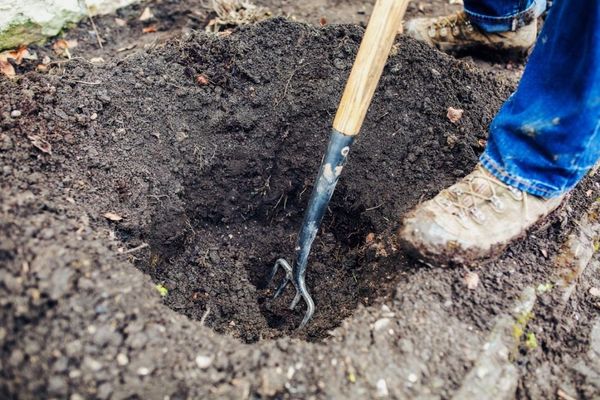

The culture loves sunny areas, protected from drafts or strong gusts of wind. However, planting in areas with partial shade is acceptable. It will be optimal to place the berry on the south side of the site near the fence or the wall of the building. It is advisable to pick up loamy or sandy loam soil, with a good percentage of organic matter. Sour and waterlogged areas should be avoided. If the pH is more than 5.5, lime is added to the soil. For too wet areas, drainage is organized.
Landing technology
They begin to prepare for planting seedlings at the end of summer. Following the recommendations of the step-by-step guide, even a gardener with no experience can perform the procedure. Stages of work:
- Dig a hole about 50 cm deep.
- Up to half the well is filled with a nutrient substrate. A mound of fertile soil is formed on top and left for 2 weeks.
- When planting, the root system of the seedling is spread over the surface of the earthen cone. The plant itself is placed at a slight angle. This is necessary for the formation of a larger number of root shoots.
- The hole is covered with earth, placing the root collar at a distance of 5-7 cm from the soil surface.
- Compaction of the filled soil.
- Water the bush, mulch the space around it.
For your information!
When a seedling is rooted in a container, it is enough for it to dig a hole 2-3 times the volume of the container.
Nuances of care
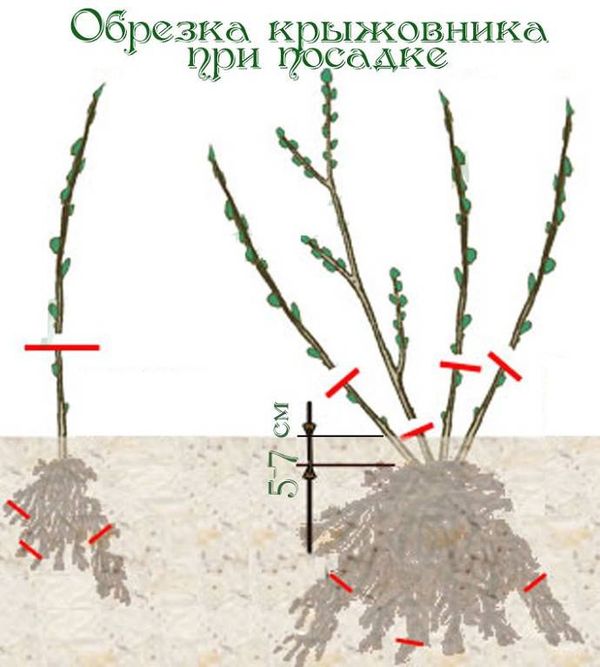

The berry is undemanding to regular watering, but you should not allow it to dry out. Be sure to moisten the plant after flowering, when the berries ripen, and if the crop has already been harvested. The culture is watered not at the root, but at a short distance from it.You can dig a groove around the perimeter of the crown and pour water into it. Due to the high yield, the plant must be fed with organic matter and mineral fertilizers. One adult bush will need about 20 kg of manure or 80-120 g of superphosphate, 70-100 g of potassium chloride and 65-80 g of ammonium nitrate during the year. It is recommended to alternate the use of organic and mineral fertilizing after a year.
To make the gooseberry grow faster, regular loosening of the adjacent soil is carried out for it. This will improve the supply of oxygen and nutrients to the root system. Only the top layer of soil should be loosened, no more than 10 cm deep. The roots of the plant lie close to the surface, they can be damaged if you dig more than the specified value. Among other things, the bush needs annual pruning. Shoots are shortened to 2-4 buds. In the spring, when new branches begin to grow, 3-5 pieces are left, and the rest are cut out. In varieties with low branching, the tops of these shoots should be shortened, and if the culture itself branches well, this stage can be omitted.
Seedling care
After planting gooseberries, the soil is watered and must be mulched. Chopped tree bark or sawdust, straw, grass cuttings are suitable.
Mulching will allow you to better maintain soil moisture, which will create good conditions for root development.
Can gooseberries be pruned after planting in the fall? Hybrid varieties are pruned low - they leave shoots about 12-15 cm high. This will contribute to the growth of more branches and the formation of a powerful crown of shrubs. Gooseberries of European varieties are more delicate and capricious, therefore only the tops of the branches are pinched.
Even a novice summer resident can get a good harvest of berries. It is enough to choose the right variety and provide the shrubs with minimal care. Today we told you how to properly plant gooseberries in the fall. We hope you find this information useful.
Planting gooseberries is not that difficult, but you need to know how to do it right. If all goes well, the plant will develop and bear fruit normally. Consider the features of planting gooseberry seedlings in spring and autumn and caring for plants.
When is the best time to plant gooseberries
There are no exact dates for planting on the plots of private houses or summer cottages; berry bushes can be planted in the autumn and spring months. Let's consider the advantages and disadvantages of both options.
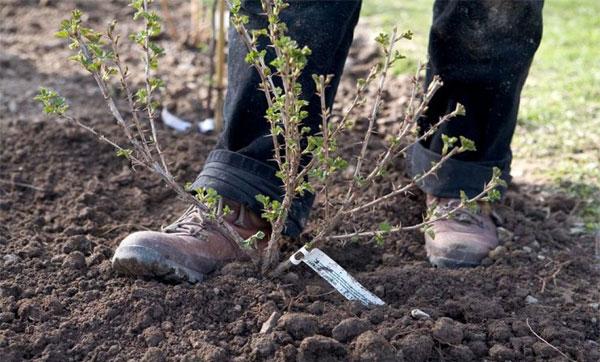

Autumn planting
It is preferable to plant gooseberry bushes in the fall, around September-October, after the leaves have fallen from the bushes, but before the onset of constant cold weather. Experienced gardeners say that planting gooseberries in autumn is better because at this time of the year it is much easier and faster to take root, it is easier to adapt to new conditions, and later it blooms and begins to bear fruit faster.
But so that he does not disappear in winter, he must have time to land at least a month or one and a half before a steady cold snap. If you plant a gooseberry seedling later in the fall, it will not have time to take root and may freeze out in the cold winter, then it will have to be planted again. It is recommended to plant seedlings with open roots in the fall, not in the spring. Gooseberries with a closed root system take root well with any planting option.
Spring planting
In the spring, planting work can also be carried out, although at this time of the year the shrub takes root a little worse. Planting dates - after the snow melts, when it gets a little warmer. Again, it is necessary to have time to plant the gooseberries before it becomes completely warm and buds bloom on it - with the blossoming leaves, the plants take root much worse or do not take root at all. Roughly in many regions, gooseberries should be planted in the spring of April.
Spring or autumn: when is it better to replant
The gooseberry tolerates a change of habitat quite easily, it can be transplanted both in spring and in autumn. And even in the summer, if such a need is urgently needed. But nevertheless, in the fall, it is preferable to transplant a shrub, because at this time the plant completes its growing season, has successfully borne fruit and begins to prepare for wintering. Sap flow slows down, the ground part stops growing. The bush passing into the dormant stage is much easier to adapt to a new place, since it will immediately direct all its forces to the development of the root system.
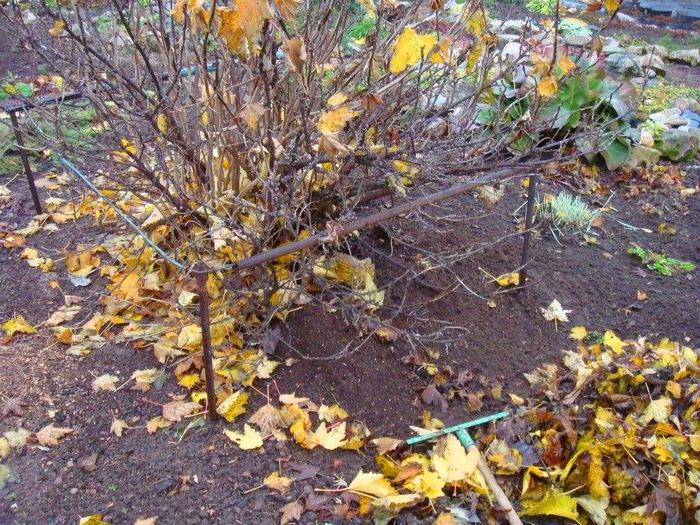

It is best to transplant gooseberries in the fall, when the foliage has already flown
The best time for transferring gooseberry bushes is the second decade of September. In regions with harsh climatic conditions, this can be done earlier, starting at the end of August. In warm southern areas, planting is possible even in early November. Before the onset of real frosts, at least 4–5 weeks should remain for the shrub to take root well.
If for some reason it was not possible to tackle gooseberries in the fall, then a spring transplant is also possible. But the difficulty arises with the fact that this berry bush wakes up extremely early after winter. With the onset of the first warm days, sap flow begins, the kidneys swell and burst almost immediately. At this moment, you can no longer touch the plant, since in a new place it will hurt for a long time and lag behind in development, or it may not take root at all. The main strength of the gooseberry is directed towards the growth of the upper part, not the formation of roots.
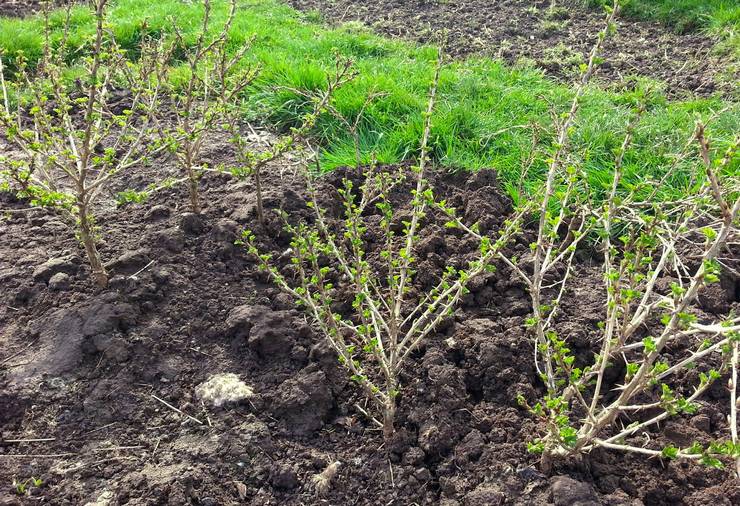

When the foliage has already begun to bloom, it is undesirable to transplant gooseberries.
In the spring, you can dig up a gooseberry bush only before the juices start moving. The most suitable spring month for this is March, when the snow cover has already melted. In the northern regions, this is possible in early April. However, very often the ground is still frozen and it will be impossible to extract the plant from the ground. It is necessary that the earth has already warmed up enough, but the plant has not yet started to grow... It is sometimes extremely difficult to guess this moment.
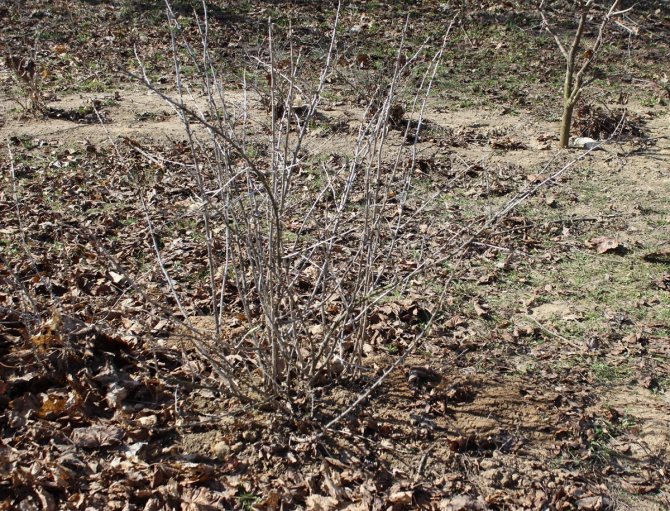

Gooseberries can be transplanted in the spring, but before the buds swell.
In principle, in case of emergency, gooseberries can be transplanted in the summer. But since at this time the green mass is actively growing, the bush will take a very long time to restore the damaged root system.
Last year, we had to urgently transplant a gooseberry bush in the spring, which was badly damaged by the snow that had come down from the roof of a neighboring house. The snowdrift was large and thawed for a long time, the plant was dug up only at the end of April with almost blossoming leaves. For him they chose another, safer place, where it is drier and there is no danger of falling snow blocks. The gooseberry took root for a long time and almost stopped growing, the fruits that were set fell off.
Video: when and how to transplant gooseberry bushes
Selection and preparation of a seedling
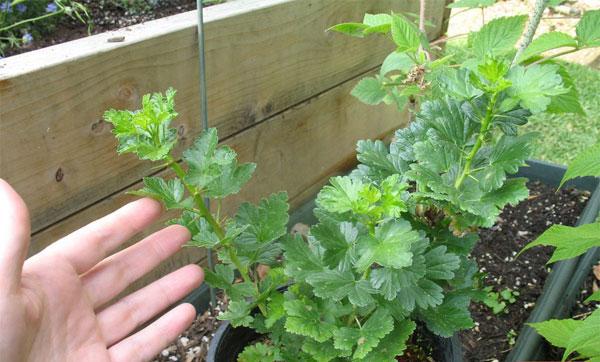

Gooseberries for planting should be varietal, seedlings not older than 2 years, with voluminous fibrous roots, with 2-3 even shoots. The buds should be unopened, no diseases or traces left by pests should be visible on them and on the bark of the shoots. The thickness of the shoots is about 5 mm, the bark is smooth, light, which indicates their youth.
Preparing the gooseberry for planting: a day before it, soak its roots in a bucket with a solution of any growth stimulant (if the root system is open, if closed, then just spill the soil in a pot). Before planting, cut off the ends of soaked or broken roots and dip them into a clay-dung chatter.
Choosing a quality seedling
Do not rush to buy the first seedlings you come across, even if the planting time is running out. Carefully inspect the root system of the plant, do not miss the inspection of the shoots. Quality gooseberry seedlings must meet the following criteria:
- The seedling is at least two years old.Annual plants most often have an underdeveloped root system, and therefore do not take root well. The exception is seedlings grown in containers.
- The seedling has at least two shoots, each 30 cm in length or more. Roots at least 25 cm long.
- There are no signs of disease and root rot.
It is difficult to assess the condition of seedlings with a closed root system. You can understand the quality of the planting material if you lift it by the branches - normally the plant firmly "sits" in the pot, does not hang out in it and is not immediately removed. These signs indicate that the roots are well developed, the gooseberries were grown in a pot, and were not transplanted before being sold.
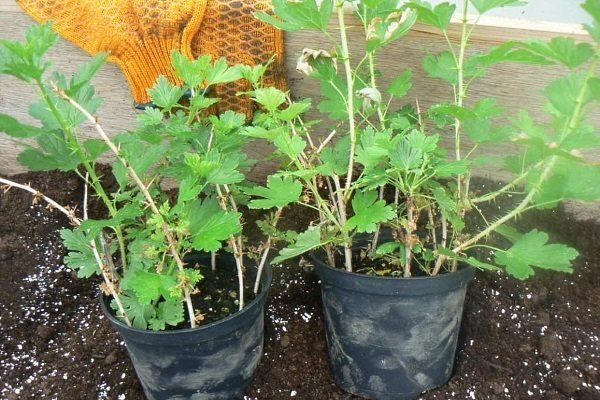

Gooseberries are susceptible to powdery mildew, therefore it is better to buy varieties that are resistant to fungal diseases - Muscat, Golden Light, Date and others.
Site selection and soil preparation for planting
A plot for gooseberries should be chosen sunny, open, but in the sun itself, of course, it is better not to plant. Light partial shade from low trees, buildings or fences is allowed. It is not recommended to place near tall trees and near houses: in the shade, the yield of gooseberries drops sharply, the berries become small, sour in taste.
The place under the gooseberry should be protected from piercing winds, but at the same time well ventilated. In a lowland or in swampy areas, a crop cannot be planted; its roots rot in wet soil. If the soil is damp, then the bushes can be planted on specially prepared mounds.
The soil in which the gooseberry grows well is fertile, rich in organic matter, well-groomed loams, chernozems and sandy loams, loose, light, into which air and moisture easily penetrate. The acidity of the soils is neutral, if the soil shows an acidic reaction, it must be calcified (at least a month before planting).
Soil preparation on the site for gooseberries: remove all debris and remnants of the previous culture, weeds, select their roots. Dig up at least on a shovel bayonet, add humus - 1-2 buckets, or the same amount of compost, up to 1 kg of ash per 1 sq. m. Instead of organic matter, you can use urea, potassium sulfate and superphosphate. They are brought in according to the instructions.
Work is carried out in the fall at least a month before planting, or the treated soil is left until spring. In the latter case, the clods of earth do not break: they must completely freeze in frost so that the pests and their eggs die in them.
How to properly plant an autumn gooseberry
Autumn planting of seedlings has several nuances.... First of all, the gardener chooses a suitable place for planting a plant.
Seat selection
The area where the gooseberry will grow should be sunny and open.... Light partial shade from small plants, low structures or a fence is allowed. It is impossible to plant gooseberries near houses, summer cottages or tall trees with a rich crown: the yield of the plant in the shade will rapidly decrease, and the berries will become small and sour.
The place must be reliably protected from piercing winds, but at the same time have good ventilation... It is not recommended to plant shrubs in swampy areas or lowlands - the roots of the plant will quickly rot in wet ground. If the soil in the garden is damp, gooseberries are planted on previously created mounds of soil.
Important! Gooseberries are not suitable for proximity to plants that have a rapidly growing root system - raspberries and strawberries. In addition, it is not recommended to plant it next to walnuts and black currants.
Required materials and tools
For planting gooseberries you will need prepared seedlings, shovel, gloves, mineral fertilizers and organic matter: compost or humus, peat, superphosphate or bone meal, as well as potassium sulfate, which can be replaced with potassium salt or wood ash.
Step-by-step instruction
How to plant gooseberries in the fall:
- Fill the dug hole halfway with soil nutrient mixture.
- Sprinkle lightly with water (you can skip this step and water only after planting).
- Make a small cone-shaped mound in the center of the hole if the root system of the seedling is open. If not, carefully plant the seedling without disturbing the earth seal (lump).
- Set the plant in the center of the mound and gently spread the roots down to the sides. It is important that they do not bend or stick up.
- Cover with soil, lifting and shaking the seedling so that the soil fills the space between the roots.
- Compact the soil and anchor the plant.
- Make a small hole around the trunk.
- Water the plant abundantly with water (about 1 bucket of water). Pour the liquid out gradually, waiting for each portion to be absorbed.
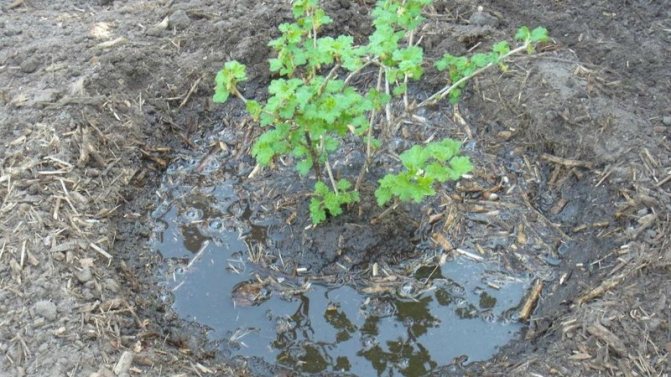

What mistakes to avoid
Novice gardeners often make mistakes when planting shrubs.:
- choose a low-quality seedling;
- incorrectly determine the landing date;
- plant the plant in a shaded place;
- do not add fertilizer to the hole before planting;
- they plant bushes close to each other - such plantings are poorly blown, which is why the plant is often sick;
- do not prune after planting;
- do not maintain the moisture necessary for gooseberries.
Scheme and step-by-step instructions for planting gooseberries
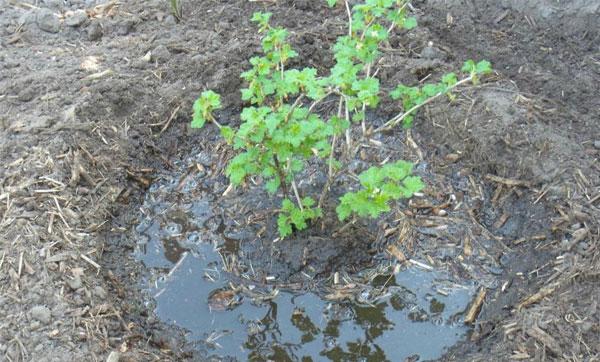

On the day of planting, you need to level the ground with a rake, making the site even. Then, at a certain distance, dig holes for the seedlings. Their diameter and depth should not be less than 0.5 m. The gooseberry planting pattern may be different, it all depends on the variety and growth force of the bushes. But plants cannot be placed in a row closer than 1.5 m from each other, row spacings must be at least 2 m. The same amount must be retreated from fences, buildings and low trees.
Step-by-step landing instructions:
- Pour a bucket of fertilizer mixture into each hole, consisting of 1 bucket of humus, 0.3 kg of ash (or about 60 g of any potash fertilizer), 0.2-0.3 kg of superphosphate, a little lime.
- Pour a layer of earth on top and mix everything.
- Pour in a bucket of water and wait until it is absorbed.
- Put a seedling in the middle, spread its roots so that they diverge in all directions, but do not rise up.
- Sprinkle the plant with soil that was taken from the very bottom of the planting hole when digging it. Pour it just above the root collar (5 cm) and compact it a little around the seedling.
- Cut off the gooseberry shoots with pruning shears, leaving no more than 5 buds on each.
- Dig a circular watering hole, where water will be poured in the future during irrigation.
- Mulch the surface of the ground near each seedling with some kind of plant material like straw, hay, sawdust or shavings. You can also use agrofibre. This will prevent the soil from drying out excessively and will help the seedling settle in moist soil more quickly.
Planting methods
Gooseberries are planted with open and closed root systems... The focus is on the soil.
At what distance and at what depth to plant
The optimal size of the pit for the gooseberry is 50 cm deep and 50 cm in diameter... Leave at least 1.2-1.5 m between the bushes. In addition, the distance to the nearest "obstacle" - a fence or a building - must be at least one meter.
So that the plant takes root faster, before planting, a soil mixture of organic and mineral fertilizers is introduced into the pit:
- fertile upper words of the soil left after digging a hole;
- a bucket of humus or compost;
- glued high peat;
- bone meal (350 g) or superphosphate (no more than 100 g);
- wood ash (350 g) or potassium salt (no more than 40 g).
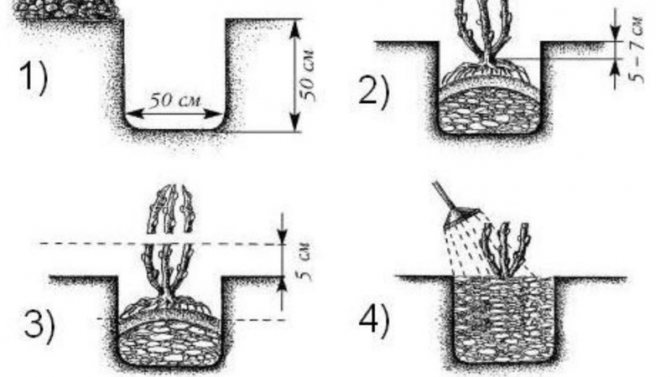

Further care after planting
Any seedling will take root and grow faster if you take care of it. Outdoor care for a freshly planted gooseberry is straightforward. The bush requires watering, loosening the soil, if there is no mulch and, possibly, treatment against diseases and pests, if any.
Young gooseberries are watered in the spring, first in a day or two (if there is no rain), then once a week. In the fall, watering is likely to be needed even less often, and if the autumn is rainy, then you can do without watering altogether. Seedlings planted in the spring must be watered in the heat, because they have not yet developed a powerful enough root system to get water from the depths of the soil, so in a drought they may dry out or simply will not develop.
Watering is carried out in the mornings or evenings, only with warm water heated in the sun and separated from chlorine in the air. Usually watered from a watering can, bucket, hose, and if there are a lot of bushes, then it makes sense to lay a drip irrigation system for them. Then you don't have to worry about watering. There is no need to feed the gooseberries in the year of planting, the young bushes will have enough food introduced into the planting pits.
Gooseberries at any age can get sick or be attacked by pests, so you need to examine it from time to time so as not to miss the first signs of disease or the presence of harmful insects. If this happens, you need to immediately treat the bushes with insecticides or fungicides. However, folk remedies will also be effective for young plants, especially if the disease is at an initial stage or if the pests have not yet had time to multiply strongly.
In autumn, the first pruning is carried out: excess young shoots are removed, leaving 2-3 new shoots in each bush. After pruning, the plants are prepared for winter: the ground around them and the base of the bushes are covered with mulch by 10-15 cm. It is recommended to cover the gooseberries in the first autumn even in the southern regions (in case of a snowless winter), but in the northern ones this should be done without fail. In the spring, as soon as it gets warmer, the mulch needs to be removed and then a new layer should be laid.
Gooseberry is an amazing berry that makes delicious preserves, jams, compotes, and its fresh taste is unique. In addition to a pleasant taste, it can also give a person benefit. Growing an unpretentious shrub in your garden is a real happiness for a gardener! And for cultivation and fruiting to proceed safely, you need to plant the seedling correctly.
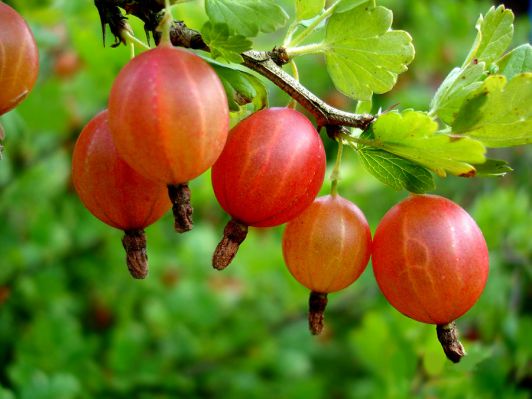

Choosing the timing of the transplant


It is advisable to move the gooseberry on a cloudy day so that the plant does not lose a lot of moisture.
The most favorable terms for transplanting gooseberries are from the second half to the end of September. In places with a harsh climate and early winter - late August. In the south, the dates can be shifted to early or mid-October.
The main landmark is the end of the growing season of the plant, when the first fall of foliage begins. At this time, the summer heat subsides, and at least 30 days remain before the onset of frost. If the conditions are met, the gooseberry takes root well in a new place and has time to prepare for wintering.
When to plant gooseberries
When is it better to plant gooseberries - in spring or autumn? It is possible to plant in open ground both in spring and autumn. But experienced gardeners and experts believe that it is better to plant a plant in the fall.
The plus of spring planting is the abundance of moisture in the soil, which was formed after the snow melts, thanks to it, the shrub will take root faster. Planting gooseberries in spring has its drawbacks.... For example, it is more difficult to choose a high-quality seedling, as a rule, sellers sell out what they could not sell in the fall. It is easy to skip the appropriate dates and plant too late, which will make the plant frail or even ruin it.
Pros of planting in the fall:
- In garden centers and other points of sale, there is a huge selection of planting material. You can easily choose a healthy and quality seedling that suits your requirements. There are also many interesting varieties in the assortment.
- In the fall, the gardener has more free time than in the spring. The gardener can plant the bush correctly without haste and hassle.
- After the autumn planting, you do not need to spend a lot of time on leaving.All care works will begin in the next summer cottage season, in the spring.
- And among other things, it is believed that the survival rate of seedlings is higher.
The cons of the autumn procedure is the possibility of freezing of seedlings, because of this, the plant can become weak and frail or even die. For this reason, you need to very carefully choose the time for the procedure in the fall.
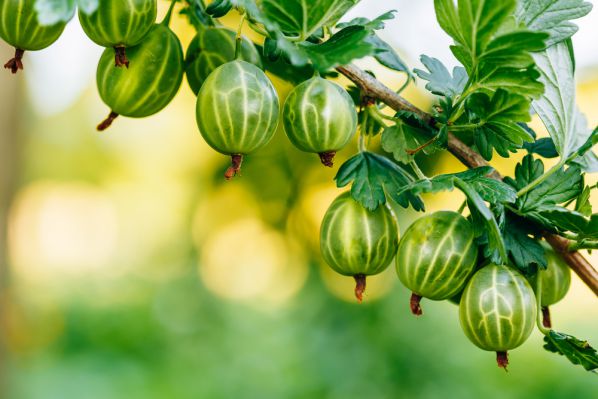

Pros and cons of autumn planting
Gooseberries are traditionally planted in early spring or fall. The number of "risks" for survival is much less in the second option, and here's why:
- in the fall, a young gooseberry manages to take root before the first serious cold weather;
- the soil around the bush during the winter will be well compacted in a natural way, which will provide better root nutrition in the future;
- in the spring the bush will begin to fully grow and develop, it will not be afraid of drought and spring repeated frosts;
- choosing the time for planting in the fall is easier, you just need to have time to plant the plant about 2 weeks before the first frost.
There are also disadvantages when laying the gooseberry in the autumn:
- in the case of a very cold (up to 40 ℃), little snow and prolonged winter, a young plant may not survive;
- increased requirements for the quality of autumn seedlings (they must be completely healthy in order to have time to take root before the cold weather).
On a note. The disadvantages of autumn planting can be turned into one big plus: if the seedling survives the first winter, this means that it will not take up space in the garden in vain. A rich harvest of gooseberries is guaranteed.
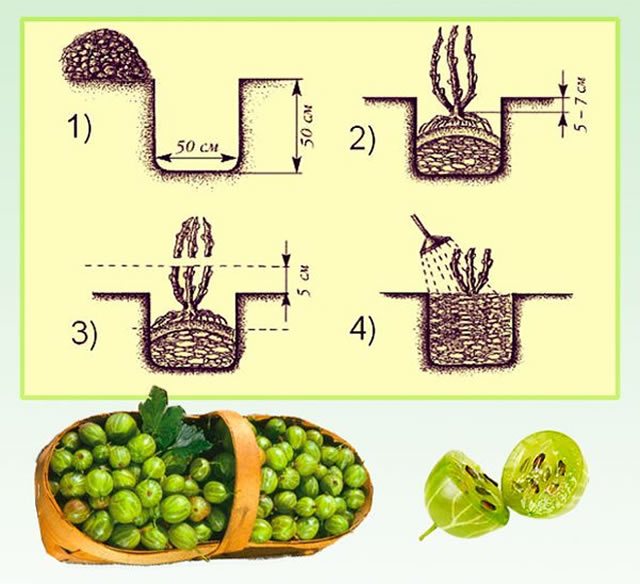

Planting dates for gooseberries in autumn and spring
The optimal timing of planting gooseberry seedlings in spring fall in early to mid-April, you need to do this before the kidneys swell... For example, in the South, you can already plant in early April, in Siberia, in the Urals - at the end of April, in the Volga region - in mid-April, in the Middle Belt (Moscow region) - in mid-April. But when choosing the time, you also need to be guided by the temperature conditions! It should keep t + 4-6 degrees outside.
Advice! Planting in spring is best on a cloudy, windless day.
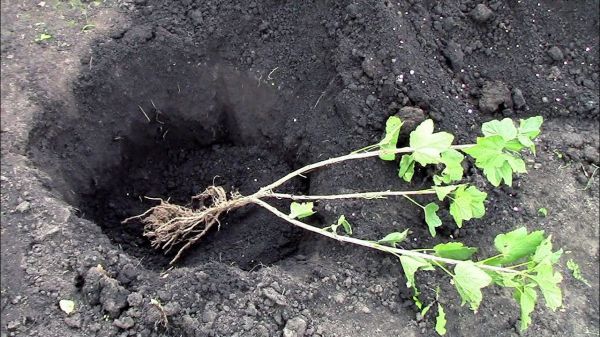

What month to plant in autumn? The timing of planting gooseberries this season should be chosen based on the frost. I.e you need to plant 4 weeks before the onset of frost, in this way the plant will be able to grow young roots and take root in the open field. The air temperature during the day should be 10 degrees Celsius, and at night - 5.
The approximate time for the procedure falls in early September-mid-October. For example, in the South (Krasnodar Territory (Kuban), North Caucasus) planting in the fall is best done in early to mid-October, in the middle lane (Moscow region) - at the end of September, in Siberia, in the Urals, in the Leningrad region - early to mid September, in the Volga region - in the middle and end of September. But first of all, you need to build on the temperature and weather conditions!
If you find that the frost came unexpectedly and too early, then you should postpone the procedure to spring so as not to ruin the planting material.
By the way! Do you know what year the gooseberry bears fruit after planting? Active fruiting begins in three to four years.
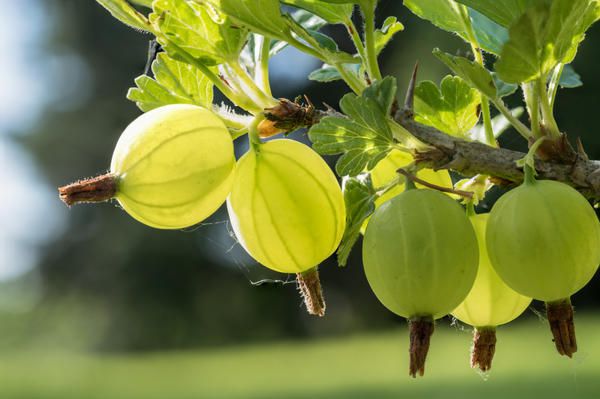

Landing dates
It is customary to plant gooseberries in spring.: like currants, it is planted early, before April. However, a warm and dry autumn is quite suitable for this procedure - even before the frost begins, the planted plant will have time to take root, get stronger in order to start growing rapidly with the arrival of next spring. In addition, the growth of the overgrown root system is faster at low temperatures.
Can bushes be planted in October? Yes, it is quite. Experienced gardeners assure that the optimal time for planting is from mid-September to the end of October.... The more accurate period depends on the climatic conditions of each region.
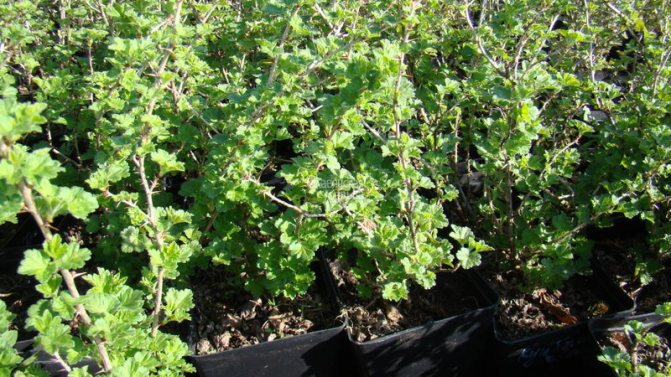

Outdoor Gooseberry Planting Guide
Proper landing includes several important preparations.The following step-by-step instructions will tell you how to properly prepare and plant gooseberries, describing in detail all the necessary steps.
Seat selection
The bushes of the plant will stay in one place for many years. Therefore, you need to choose a landing site responsibly, and the following recommendations will help you with this:
- The place should be warm, well lit by the sun (but the plant also tolerates light partial shade).
- The place is protected from cold winds and drafts.
- The groundwater is deep, there is no stagnation of moisture and swampiness.
- Lowlands should be avoided, it is better to choose flat or slightly raised areas.
- Remember the unfavorable predecessors - currants, raspberries. After them, planting a crop is not recommended due to the fact that they take away the nutrients that gooseberries need, and they also have the same diseases and pests. Also, you can't just plant a plant next to them.
Summing up, I would like to note that stagnation of moisture is contraindicated for culture, since it can cause disease or even death. But the sun, warmth and protection from the wind are welcome.
If there is still stagnation of moisture and a high occurrence of groundwater on the site, then it is recommended to make high beds - pour soil 35-50 centimeters thick and 80 centimeters wide at the planting site.
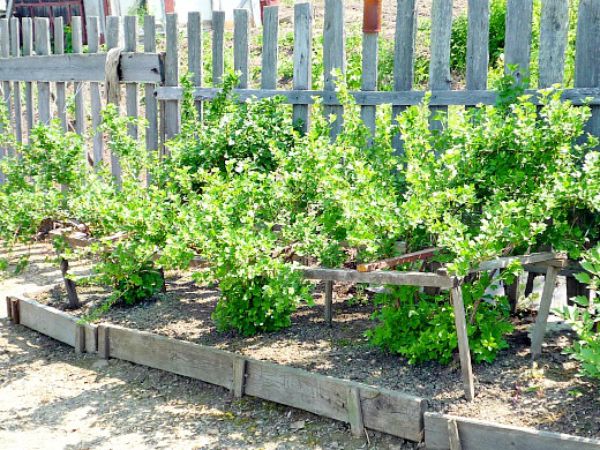

Soil selection
The culture prefers soils with a neutral or slightly acidic reaction (5.5-6.5). The culture does not like acidic soils, so if the soil is acidic, then it is necessary to lime the site. The optimal soil for growing gooseberries is sandy loam, medium and light loamy.
How to care for a gooseberry seedling after planting
Care after planting in spring or fall is one of the most important and key steps in successful gooseberry cultivation. The plant needs different activities:
- To properly care for a plant after planting, you need water properly. Watering after the procedure in the spring at first is done once a week, depending on weather conditions. After the autumn procedure, watering the seedling is not worth it, if the autumn is wet and rainy, if it is dry, then after planting it should be watered two or three more times before the onset of cold weather (the watering rate is five liters per one bush).
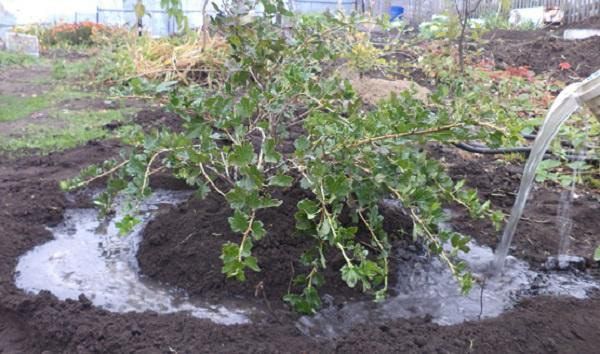

- After planting in the spring, it is necessary until the end of the season regularly eliminate weeds and loosen the garden... Loosening is carried out about once a week and after watering.
- Be sure to implement mulching... The mulch will prevent the soil from drying out and the formation of an earth crust. Peat, sawdust, humus can be used as a mulching material.
- If fertilizers were introduced into the pit, then produce top dressing for two to three years after planting should not, the plant has the necessary supply of nutrients.
- As one of the main elements of gooseberry care after planting is pruning a seedling... The shoots of the plant should be cut to 5-7 buds. Pruning is beneficial and stimulates the branching process.
- If the bush was planted in sandy soil, then organic fertilizers should be applied annually, if in loamy, then it is imperative to loosen it.
Video: features of caring for a shrub.
The scheme of the procedure is not complicated, even an inexperienced gardener will cope with the task. If you plant the shrub correctly, you can get a strong and healthy plant, and in the future you can enjoy a rich and tasty harvest. And the step-by-step guide described above will come to the rescue in this matter.
Gooseberry care after autumn planting
There is almost no need to take care of the gooseberries in a special way after planting, except that you must, without fail, be strong enough. cut off its shoots (aboveground part of the bush).
Of course, if they have not yet been cut by the seller in advance, because, as a rule, they are sold or sent in this form.
How to cut tightly?
If the roots are weak and poorly developed, then the height of the shoots should be no more than 5-10 cm (i.e. 2-3 healthy buds), if stronger, then up to 15 cm is possible (i.e. 3-4 buds).
Important! Now the main goal of the plant is to grow the root system in order to take root in a new place and survive the winter (not freeze out). The development of the aboveground part is not required, it is for this that it is shortened and equalized with the underground (in this case, even less is done).
Further, in order to avoid freezing of the roots and protect them from bulging, it is very desirable mulch gooseberry near-stem circle with a layer of 5-8 cm. For this, humus, mown grass, hay, straw or rotted sawdust are perfect.
Mulch can also help prevent root drying and excess moisture evaporation.
Of course, we must not forget about watering, especially if the autumn is dry. In general, the autumn natural moisture is usually enough.
Later in the composition basic care for gooseberries will include the following:
- annual autumn pruning of gooseberries after fruitingor in early spring;
Basic trimming gooseberries are usually performed after fruiting (in autumn), and in the spring they do only corrective, or rather sanitary pruning.
Of course, if you have not had the opportunity to prune the gooseberries in the fall, then pruning in the spring is better than not pruning at all.
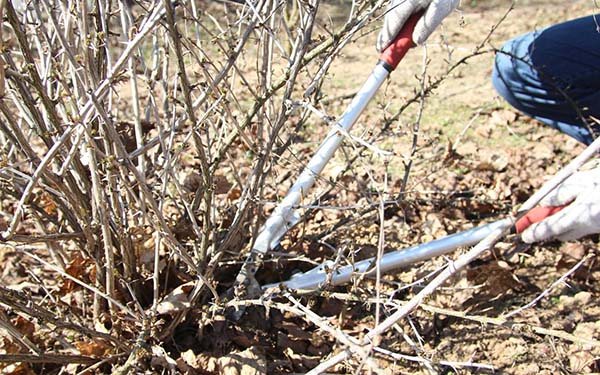

- fertilization;
By the way! More information about when and what to feed gooseberries in spring and summer, you will find in this material about feeding currants (because they are similar).
It should be understood that no additional fertilizing will be required in the next 2-3 years, of course, if you have carefully filled the planting hole with everything you need.
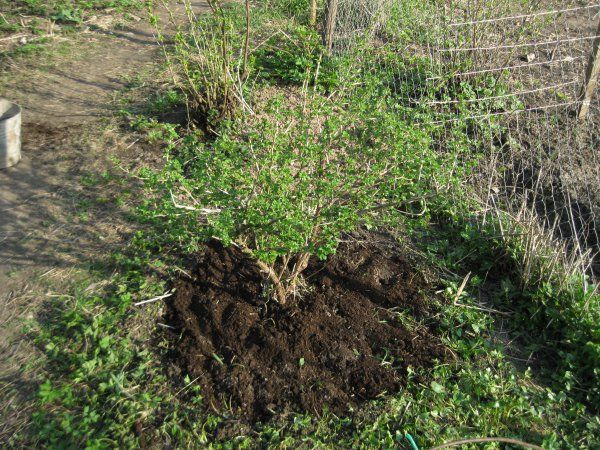

- carry out treatments for diseases and pests.
Important! After winter, still in early spring, You can pour boiling water over the gooseberries (similar to currants).
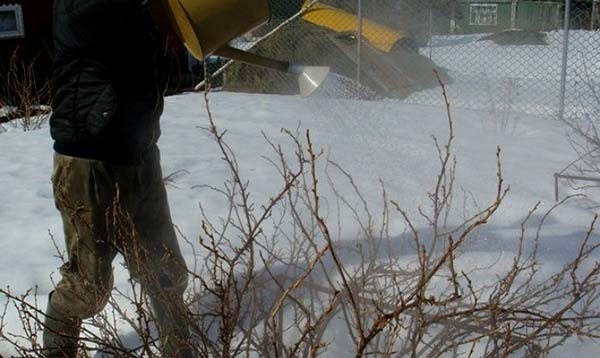

And then to carry out a full-fledged spring spraying shrubs with fungicides and insecticides
(means against diseases and pests), as described in detail
in this article.
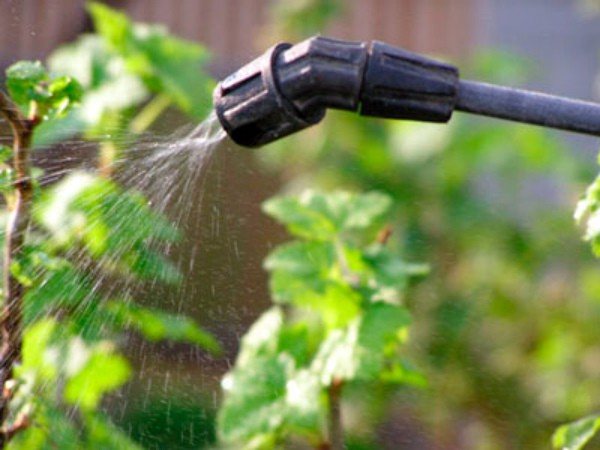

- If the gooseberry has grown too much (began to interfere)
or his fruiting has noticeably decreased and he generally stopped developing - it's time for him
plant or transplantbefore multiplying in one of several ways.
By the way! The site has a detailed article about how to transplant currants correctly in spring, summer and autumn (the technique is basically the same).
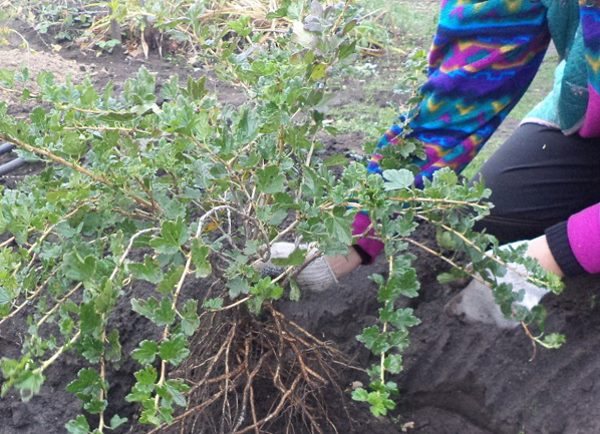

- Properly care for gooseberries in the fall and prepare for winter, as described in detail in this article about currants (and for gooseberries everything is the same).
Video: planting and caring for gooseberries

